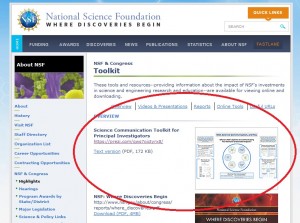 The following blog post is from the National Science Foundation Office of Legislative and Public Affairs on improving science communication.
The following blog post is from the National Science Foundation Office of Legislative and Public Affairs on improving science communication.
A new interactive resource available through NSF’s website will help NSF-funded principal investigators and their institution public information officers understand better the process for creating communications tools, such as videos and feature stories, so that NSF more effectively communicates the science it funds.
This user-friendly resource, which is essentially a decision tree that shows examples of all of NSF’s Office of Legislative and Public Affairs (OLPA) capabilities, is located with NSF’s communications resources along with a text-only version. (Click on “Science Communication Toolkit for Principal Investigators.”) In addition to showcasing all of NSF’s communications vehicles with descriptions, examples and clickable links, the toolkit also contains:
- Statements on the importance and benefits of science communication
- Suggestions for communicating effectively, and
- The ideal communication chain between principal investigators, NSF program directors, and university public information officers
“NSF places importance on the communication of NSF-funded science and associated activities to various audiences including the general public and non-experts,” said Dana Topousis, acting director for legislative and public affairs. “This new tool should be quite helpful in not only informing principal investigators and their public information officers of available options and ways to think about communication, but also in directing NSF program staff to access our resources more efficiently and reminding them to use them.”
The toolkit may at first look like a presentation, but it is actually an application that users can explore and interact with at their own pace to help them stretch how they communicate about research and broader impacts. Instructions are located in the tool’s description and in the application itself. The main view has several frames where users can dig deeper into different aspects of communication. One frame is a circle where users can click and see all available communications vehicles and how they differ from one another. To see each portion in detail, users merely click inside the circles or the other frames. Links to videos or articles show real examples of the communications offerings as well. And to make sure the link isn’t lost, users can bookmark it in their browser for easy access.
“The goal is make the process of communication easier,” said the toolkit’s creator, AAAS Science & Technology Policy Fellow Gregory Mack, who worked in consultation with the NSF Physics Division and OLPA. “When program officers have an idea or when their PIs come to them with something to communicate, they can use this resource to have a better idea of what to do and who to talk with in OLPA to make it happen.”
This resource will be updated by NSF OLPA whenever communication vehicles and options are modified.









